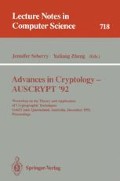Abstract
We address the following problem: given a random seed secretly shared among a group of individuals, non-interactively generate pieces corresponding to a much longer shared pseudorandom sequence. Shared randomness is an essential resource in distributed computing and non-interactive ways of generating it can be useful in applications such as Byzantine Agreement, common coin flipping or secure computation protocols.
Our first result is negative: well known cryptographically strong pseudorandom number generators cannot be evaluated without interaction and, in particular, it is shown that constructions that recursively apply a one-way function to a random seed and output at each iteration the simultaneously hard bits in the input of the one-way function are actually incompatible with a homomorphic evaluation.
On the other hand, we show that pseudorandom generators that can be both proven cryptographically strong and sharedly evaluated without interaction do exist. A concrete implementation, under the RSA assumption, is described.
Supported by Japanese Ministry of Education, Science and Culture Scholarship, No. 890864.
Preview
Unable to display preview. Download preview PDF.
References
S. Akl and P. Taylor. “Cryptographic solution to a problem of access control in a hierarchy.” ACM TOCS, 1, 1983, pp. 239–248.
W. Alexi, B. Chor, O. Goldreich and C.P. Schnorr. “RSA and Rabin Functions: Certain Parts are as Hard as the Whole.” SIAM Journal on Computing, vol. 17, no. 2, April 1988, pp. 194–209.
M. Ben-Or, S. Goldwasser and A. Wigderson. “Completeness Theorems for Non-Cryptographic Fault-Tolerant Distributed Computation.” Proc. 20th STOC, ACM, 1988, pp. 1–10.
D. Beaver. “Foundations of Secure Interactive Computing.” Proc. Crypto '91, Springer-Verlag, LNCS vol. 576, pp. 377–391.
J.C. Benaloh. “Secret Sharing Homomorphisms: Keeping Shares of a Secret Secret.” Proc. Crypto '86. Springer-Verlag, LNCS vol. 293, 1987.
M. Blum and S. Micali. “How to Generate Cryptographically Strong Sequences Of Pseudo-Random Bits.” Proc. 22nd FOCS, IEEE, 1982, pp. 112–117.
D. Beaver, S. Micali and P. Rogaway. “The Round Complexity of Secure Protocols.” Proc. 22nd STOC, ACM, 1990, pp. 503–513.
J. Carter and M. Wegman. “Universal Classes of Hash Functions.” Journal of Computer and System Sciences, 1979, vol. 18, pp. 143–154.
B. Chor and C. Dwork. “Randomization in Byzantine Agreement.” Advances in Computing Research, vol. 5, JAI Press, 1989, pp. 443–497.
B. Chor, S. Goldwasser, S. Micali and B. Awerbuch. “Verifiable Secret Sharing and Achieving Simultaneity in the Presence of Faults.” Proc. 26th FOCS, IEEE, 1985, pp. 383–395.
J.-H. Evertse and E. van Heyst. “Which New RSA-Signatures Can Be Computed from Certain Given RSA-Signatures?” Journal of Cryptology, vol. 5, no. 1, 1992, pp. 41–52.
P. Feldman. “A Practical Scheme for Non-Interactive Verifiable Secret Sharing.” Proc. 28th FOCS, IEEE, 1987, pp. 427–437.
Y. Frankel and Y. Desmedt. “Classification of ideal homomorphic threshold schemes over finite Abelian groups.” Proc. Eurocrypt '92. To appear in Springer-Verlag, LNCS.
P. Feldman and S. Micali. “Optimal Algorithms for Byzantine Agreement.” Proc. 20th STOC, ACM, 1988, pp. 148–161.
Y. Frankel, Y. Desmedt and M. Burmester. “Non-existence of homomorphic general sharing schemes for some key spaces.” Proc. Crypto '92. To appear in Springer-Verlag, LNCS.
O. Goldreich, S. Micali and A. Wigderson. “How to Play Any Mental Game.” Proc. 19th STOC, ACM, 1987, pp. 218–229.
S. Goldwasser, S. Micali and C. Rackoff. The Knowledge Complexity of Interactive Proof Systems. SIAM Journal on Computing, vol. 18, no. 1, Feb. 1989, pp. 186–208.
J. Håstad. “Pseudo-Random Generators under Uniform Assumptions.” Proc. 22nd STOC, ACM, 1990, pp. 395–404.
R. Impagliazzo, L.A. Levin and M. Luby. “Pseudo-Random Generation from Oneway Functions.” Proc. 21st STOC, ACM, 1989, pp. 12–24.
R. Impagliazzo, M. Naor. “Efficient Cryptographic Schemes Provably as Secure as Subset Sum.” Proc. 30th FOCS, IEEE, 1989, pp. 236–241.
S. Micali and T. Rabin. “Collective Coin Tossing without Assumptions nor Broadcasting.” Proc. Crypto '90, Springer-Verlag, LNCS vol. 537, 1991.
S. Micali and P. Rogaway. Secure Computation. Proc. Crypto '91, Springer-Verlag, LNCS vol. 576, pp. 392–404.
T.P. Pedersen. “Non-Interactive and Information-Theoretic Secure Verifiable Secret Sharing.” Proc. Crypto '91, Springer-Verlag, LNCS vol. 576, 1992, pp. 129–140.
T. Rabin and M. Ben-Or. “Verifiable Secret Sharing and Multi-Party Protocols with Honest Majority.” Proc. 21st STOC, ACM, 1989, pp. 73–85.
A. Shamir. “On the Generation of Cryptographically Strong Pseudorandom Sequences.” ACM Trans. on Computer Systems, vol. 1, no. 1, Feb. 1983, pp. 38–44.
A.C. Yao. “Theory and Applications of Trapdoor Functions.” Proc. 23rd FOCS, IEEE, 1982, pp. 80–91.
Author information
Authors and Affiliations
Editor information
Rights and permissions
Copyright information
© 1993 Springer-Verlag Berlin Heidelberg
About this paper
Cite this paper
Cerecedo, M., Matsumoto, T., Imai, H. (1993). Non-interactive generation of shared pseudorandom sequences. In: Seberry, J., Zheng, Y. (eds) Advances in Cryptology — AUSCRYPT '92. AUSCRYPT 1992. Lecture Notes in Computer Science, vol 718. Springer, Berlin, Heidelberg. https://doi.org/10.1007/3-540-57220-1_77
Download citation
DOI: https://doi.org/10.1007/3-540-57220-1_77
Published:
Publisher Name: Springer, Berlin, Heidelberg
Print ISBN: 978-3-540-57220-6
Online ISBN: 978-3-540-47976-5
eBook Packages: Springer Book Archive

